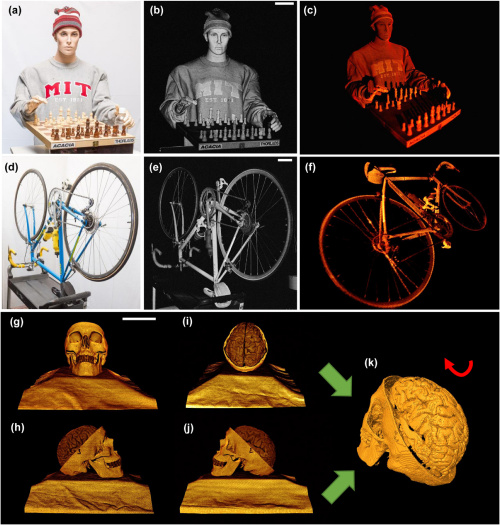Images of cubic metre volumes have been achieved with optical coherence tomography (OCT) for the first time by an industry-academia collaboration between MIT, Praevium Research, Thorlabs and Acacia Communications. The advancement could open up many new uses for OCT in industry, manufacturing and medicine, and represents important progress toward developing a fast, low-cost OCT system on a single integrated circuit chip.

Published in Optica, the consortium's research resulted in high-speed, 3D OCT imaging with 15µm resolution over a 1.5m area. The technique was used to image a mannequin, a bicycle and models of the human brain and skull. The collaboration also conducted measurements of objects ranging in scale from metres to microns.
‘Our study demonstrates world-record results in cubic metre volume imaging, with at least an order of magnitude larger depth range and volume compared to previous demonstrations of three-dimensional OCT,’ said James G Fujimoto of MIT. ‘These results provide a proof-of-principle demonstration for using OCT in this new regime.’
The new technique is believed to have uses in industrial and manufacturing settings, where it could be used to monitor processes, take technical measurements and non-destructively evaluate materials. Metre-scale OCT could also enhance medical imaging, for example, by providing three-dimensional measurements in laparoscopy or mapping structures such as the upper airway.
A tuneable vertical cavity surface-emitting laser (VCSEL) light source developed by Thorlabs and Praevium Research was used to achieve the metre range OCT. It uses a MEMS device to change or sweep the laser’s wavelength rapidly over time to perform swept-source OCT. The equipment features advanced optical components designed for telecommunication applications to overcome challenges in light detection and data acquisition previously faced by the researchers when using VCSEL light sources.
‘Research by our group at MIT and our collaborators at Praevium Research and Thorlabs indicated that the coherence length of the VCSEL source was orders of magnitude longer than other swept laser technologies suitable for OCT, which suggested the possibility of long-range OCT imaging,’ said Ben Pot of MIT and Thorlabs, a co-author of the paper.
The researchers also used a new silicon photonics coherent optical receiver developed by Acacia Communications to replace several bulky OCT components with integrated optics on a tiny, low-cost, single-chip photonic integrated circuit (PIC). The PIC receiver supports the very high electrical frequencies and wide range of optical wavelengths required for swept-source OCT, whilst also enabling what is known as quadrature detection, which doubles the OCT imaging range for a given data acquisition speed.
‘The development of OCT in the early 1990s greatly benefited from components and methods used in fibre optical communications,’ said Fujimoto. ‘And still, 25 years later, advances in the optical communications industry continue to greatly benefit OCT.’
In the Optica paper, the researchers showed that metre-range OCT can obtain a strong signal from a variety of surfaces and geometries. Their tests also indicated the technique’s performance has not reached the fundamental limits for the VCSEL laser source or PIC receiver.
The researchers are now working to develop and use even more low-cost, high-speed components with the goal of speeding up the data acquisition and processing steps. This could eventually allow real-time OCT imaging using customised integrated circuit chips, enabling low cost, portable OCT systems.
‘As PIC technology continues to advance, one can realistically expect full OCT systems on a single chip within the next five years, dramatically lowering the size and cost,’ said Chris Doerr of Acacia Communications, another co-author of the paper. ‘This would allow more people all over the world to benefit from OCT and open up new applications.’
Electro Optics OCT feature articles:

